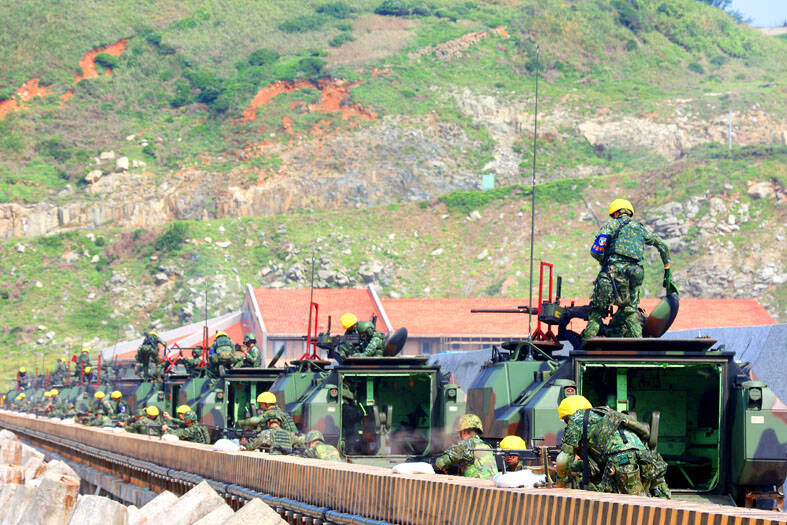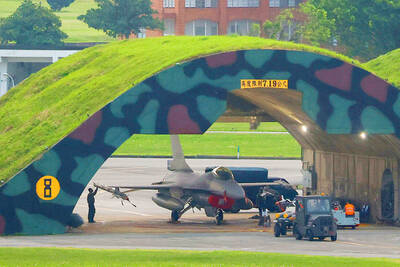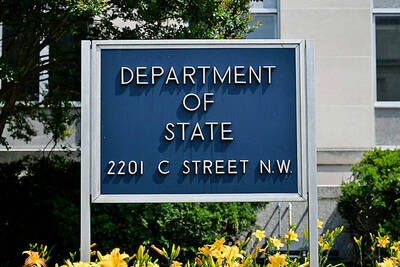Minister of National Defense Wellington Koo (顧立雄) yesterday praised Taiwanese troops for their work over the past 10 days, as the longest-ever live-fire component of Taiwan’s annual military exercises concluded early yesterday.
In a teleconference to the armed forces, Koo officially announced the end of the 10-day, nine-night Han Kuang exercises that began on Wednesday last week.
That was double the length of previous live-fire segments, which typically lasted five days and four nights, the ministry said in a statement.

Photo courtesy of the Dongyin Area Command via CNA
Koo praised the participating troops, in particular those in central and southern Taiwan, given that aside from joining the exercises, they also helped people in regions affected by Typhoon Danas.
Koo said they served as an example of military-civilian cooperation, as they not only helped defend the country, but also people affected by the typhoon, the statement said.
The 10-day drills saw the debuts of US-supplied High Mobility Artillery Rocket Systems, TOW 2B anti-tank missiles, newly purchased uncrewed aviation vehicles and a domestically built land-based version of the Sky Sword II (陸射劍二) missile, Koo said.
The exercises also mobilized the 206th Reserve Brigade, he added.
Up to 22,000 reservists participated in the 10-day drills, which tested their ability to provide brigade-sized rather than battalion-sized support, and capabilities to serve as a stronger backup to the regular troops, Koo said.
The defense chief also said that due to the “unscripted” nature of this year’s drills and because military vehicles frequently drove on the streets alongside civilian vehicles, there were several traffic incidents involving military vehicles.
Koo has asked senior military officials to look into the matter to prevent reoccurrences, the ministry said.
At least seven traffic incidents involving military vehicles or personnel were reported by local media over the past 10 days, resulting in minor injuries to five soldiers.
The first three days of Taiwan’s military exercises focused on countering China’s “gray zone” tactics, the ministry said.
The drills then transitioned to their “full-scale combat” phase, which included joint anti-landing operations on Sunday, coastal and beachhead combat on Monday, in-depth defense on Tuesday and Wednesday, and protracted warfare on Thursday and yesterday.
The final day of the exercises saw urban resilience drills conducted across eastern Taiwan and the outlying islands.
Elsewhere on the final day, personnel executed defense-in-depth tactics and simulated urban combat scenarios. Garrison troops also participated in live-fire exercises near the Taipei MRT Red Line.
At 10am yesterday, urban resilience drills were held in Hualien County, Taitung County and the outlying counties of Penghu, Kinmen and Lienchiang.
In Lienchiang, the army’s Matsu Defense Command worked with the county government to evacuate civilians to shelters.
In Hualien, police cleared roads and directed civilians to shelters, while a missile strike simulation was held at the train station in Jian Township (吉安), requiring emergency services.
In Penghu, nearly 300 tourists sought refuge in the Pier 3 shopping mall, where fire-fighting robots were deployed to the Magong power plant for disaster relief
From 6am Thursday to 6am yesterday, 11 Chinese People’s Liberation Army (PLA) aircraft were detected around Taiwan, with seven crossing the median line of the Taiwan Strait, the ministry said.
Eleven Chinese PLA vessels were also spotted in the Strait, it said.
The ministry said that the armed forces were continuing to monitor the situation and remain ready to respond as necessary.
Additional reporting by Yu Chao-fu, Hua Meng-ching
and Fang Wei-li

MISINFORMATION: The generated content tends to adopt China’s official stance, such as ‘Taiwan is currently governed by the Chinese central government,’ the NSB said Five China-developed artificial intelligence (AI) language models exhibit cybersecurity risks and content biases, an inspection conducted by the National Security Bureau (NSB) showed. The five AI tools are: DeepSeek, Doubao (豆包), Yiyan (文心一言), Tongyi (通義千問) and Yuanbao (騰訊元寶), the bureau said, advising people to remain vigilant to protect personal data privacy and corporate business secrets. The NSB said it, in accordance with the National Intelligence Services Act (國家情報工作法), has reviewed international cybersecurity reports and intelligence, and coordinated with the Ministry of Justice Investigation Bureau and the National Police Agency’s Criminal Investigation Bureau to conduct an inspection of China-made AI language

BOOST IN CONFIDENCE: The sale sends a clear message of support for Taiwan and dispels rumors that US President Donald Trump ‘sold out’ the nation, an expert said The US government on Thursday announced a possible sale to Taiwan of fighter jet parts, which was estimated to cost about US$330 million, in a move that an expert said “sends a clear message of support for Taiwan” amid fears that Washington might be wavering in its attitude toward Taipei. It was the first announcement of an arms sale to Taiwan since US President Donald Trump returned to the White House earlier this year. The proposed package includes non-standard components, spare and repair parts, consumables and accessories, as well repair and return support for the F-16, C-130 and Indigenous Defense Fighter aircraft,

CHECKING BOUNDARIES: China wants to disrupt solidarity among democracies and test their red lines, but it is instead pushing nations to become more united, an expert said The US Department of State on Friday expressed deep concern over a Chinese public security agency’s investigation into Legislator Puma Shen (沈伯洋) for “secession.” “China’s actions threaten free speech and erode norms that have underpinned the cross-strait ‘status quo’ for decades,” a US Department of State spokesperson said. The Chongqing Municipal Public Security Bureau late last month listed Shen as “wanted” and launched an investigation into alleged “secession-related” criminal activities, including his founding of the Kuma Academy, a civil defense organization that prepares people for an invasion by China. The spokesperson said that the US was “deeply concerned” about the bureau investigating Shen

‘TROUBLEMAKER’: Most countries believe that it is China — rather than Taiwan — that is undermining regional peace and stability with its coercive tactics, the president said China should restrain itself and refrain from being a troublemaker that sabotages peace and stability in the Indo-Pacific region, President William Lai (賴清德) said yesterday. Lai made the remarks after China Coast Guard vessels sailed into disputed waters off the Senkaku Islands — known as the Diaoyutai Islands (釣魚台) in Taiwan — following a remark Japanese Prime Minister Sanae Takaichi made regarding Taiwan. Takaichi during a parliamentary session on Nov. 7 said that a “Taiwan contingency” involving a Chinese naval blockade could qualify as a “survival-threatening situation” for Japan, and trigger Tokyo’s deployment of its military for defense. Asked about the escalating tensions